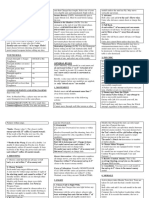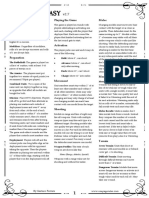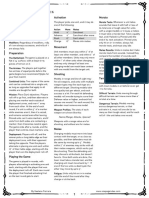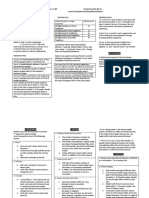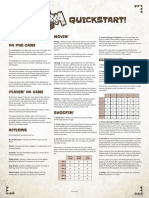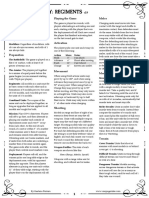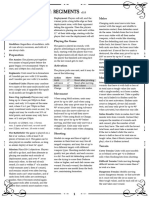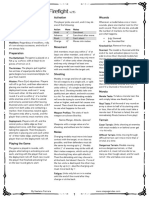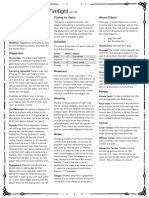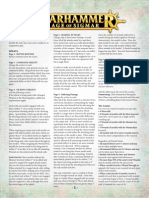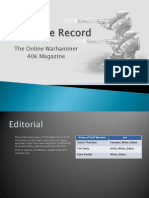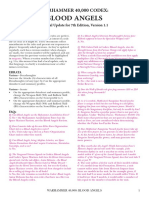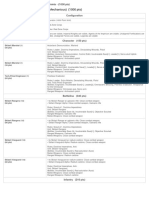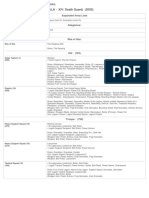For those of you unfamiliar, that’s the basic premise of the Warhammer 40k universe.
A
sprawling dystopia where all is war. For ten millennia, battle has raged from one end of the
galaxy to another, fought across countless strange and fascinating worlds, between a myriad of
factions and races. Though planets without number have burned in the name of victory,
vengeance, and heresy, still there is so end in sight to the bloodshed. If anything, the galaxy
grows darker by the day.
While 40k proper focuses on the clashes between entire armies, Killteam takes on a different
angle. Not every conflict is on an apocalyptic scale, and it is not always the largest army that
carries the day. Sometimes, amidst the screaming madness and billowing flames of a wider war,
victory or defeat lies in the hands of a small band of heroes or villains, hell bent on achieving
their missions at any cost.
“One blade, driven into the correct heart, at the right moment, will save or slay a world just as
surely as the firepower of entire armies.” – Warmaster Hokaeto, Desmaxian Crusade
--
Of course, that’s the basic lore, but let’s get into the real knit and grit of 40k Killteam, namely,
how to play.
As a note, this video is meant to teach players who are unfamiliar with playing killteam the basic
rules, and the gist of the frontmost killteam factions.
Now, much like regular 40k, even taking a glance at the rulebook is enough to discourage people
from even attempting to play, but hopefully the explanations here should make some things
pretty straightforward. I’ve found that after understanding the rules, they actually seem pretty
intuitive.
This video will cover:
1. The Phases of a Battle Round
2. An example Battle Round
3. Understanding Unit Stats & Weapons
4. The basic factions, and which one to pick
First up, the Battle Round.
Each “Mission” (read: match) of KILL TEAM is played out in a series of
battle rounds. Each round consists of a series of phases, which must be resolved in
a particular order.
1. Initiative Phase
2. Movement Phase
3. Psychic Phase
� 4. Shooting Phase
5. Fight Phase
6. Morale Phase.
Once all players in the match have completed every single phase, the round ends, and the
seconds round begins, in which each player repeats the same 6 phases again.
Also, KILLTEAM uses a six-sided dice system. Different actions may require players to roll
varying amounts of six-sided dice, but you won’t have to roll any other type of dice. For now on,
when referring to a six-sided die, I will call it a d6. So 5d6 means a players rolls 5 six-sided dice.
During this video, I will use the words “model” and “unit” interchangeably. They both mean the
same thing.
First up, the initiative phase!
INITIATIVE PHASE:
In this phase, both players roll 2D6. The player with the highest roll takes the
first turn. In games with more than 2 players, the initiative order is determined
based on the dice rolls, highest to lowest. Whoever rolls highest goes first,
followed by the second highest, etc.
MOVEMENT PHASE:
Each player will move all the models they wish to move, following initiative order.
Once a player with higher initiative has moved all the models they want to, the
next player does the same, and so on, until all players have moved their models.
Detailed below are the types of moves a model can make.
Normal Move:
Most moves made are “Normal Moves.” A model making a normal move can
move a distance equal to or less than that model’s move characteristic. Note: Each
type of model/unit will have its own movement characteristic, which is listed as a
number in inches. This number is the maximum distance a model can move during
a “Normal Move.” A model making a Normal Move cannot move within 1 inch
of any enemy models.
Advancing:
Advancing is when your unit focuses on running instead of shooting. When you
advance, roll a D6. You add the result of this D6 roll to the movement
�characteristic of your unit when determining the maximum distance your unit can
move during the movement phase. A model that Advances cannot Charge, React,
or shoot later in the battle. Once again, you cannot move within 1 inch of enemy
models.
Readying:
Instead of moving, a model can be Readied. This means that instead of moving, the
unit will prepare to fire at the first possible moment. Models in combat (within one
inch of an enemy model) cannot be readied. A readied model will shoot first during
the shooting phase, regardless of initiative order. If both players have readied
models, resolve the shooting of readied models in initiative order, before moving
onto the rest of the models.
Falling Back:
Falling back is what you do when one of your units is in melee with another unit
and you want it OUT. Since models cannot make any normal moves or ready
themselves while in melee, the only movement option a unit has if it starts the
movement phase within 1 inch of an enemy model is Falling Back.
A model that you declare to be falling back moves exactly as if they are making a
normal move, but with one extra stipulation: The movement must be away from
the model it was in melee with, and, once again, it must end its movement farther
than 1 inch away from all enemy models. A model that has performed a fallback
move cannot Advance, React, or be Readied in that phase. A model that Falls Back
can also not shoot during the same battle round that it Fell Back, unless it can Fly.
--
Now it’s time to go over Charging and Reactions.
This is one of the first complicated and dense sections of rules in the book, so pay
attention, because it’s integral to the effectiveness of melee combat.
When you pick a model to move, if, at the start of the movement phase, it is
within 12 inches of an enemy model, but not closer than 1 inch, instead of
making a normal move, you can declare that it will attempt to charge. This is
broken down into 3 easy steps.
1. First, you must declare the target(s) of your model’s charge. The targets of
the charge must be within 12 inches of your model, and the must be
somewhat close together. As long as these targets are not terribly far apart,
it’s not a big deal. Models who Charged can only attack models the they
targeted, so be careful when targeting.
� 2. Opponent reactions. When you declare a charge, any opponents take it in
turn to make Reactions with any models from their teams that are allowed to
do so, in response to being targeted. A reacting model can either fire
Overwatch, or Retreat in response to a Charge.
a. Overwatch: To attempt an Overwatch reaction shot, the target of the shot
must be visible from its starting position prior to the movement afforded by
Charging. Assuming the former is true, roll to hit. To successfully land an
Overwatch shot, your D6 must roll a 6, regardless of ANY modifiers,
barring special rules. Firing an Overwatch shot does not affect that model’s
ability to shoot later in the round. So, fire away!
b. Retreat: A model cannot Retreat if it has made a move of any kind, or has
attempted to charge, in this phase. A model CAN retreat if it has already
fired Overwatch in this phase, but it cannot do so in response to the same
charge. When a model Retreats, it can be moved up to 3 inches by the
controlling player. The Retreat move must move the Retreating model
away from the Charging model, and more than 1 inch away from other
enemy models. A model that performs the Retreat reaction cannot React or
shoot later in the battle round. (Unless it can FLY) Use Fall Back markers to
mark tokens that have Retreated.
3. After all opponents have made their desired Reactions, make your model’s
charge roll by rolling 2D6. The number rolled is the distance (in inches) your
model is allowed to Charge this turn. To make a successful Charge, your Charging
model must end its Charge movement within 1 inch of at least 1 of the target
models. It CANNOT move within 1 inch of a model NOT the target of its Charge.
To select multiple Charge targets, they must be grouped closely together. If a
Charging model does not roll high enough to complete its charge towards its
targets, the charge fails and the model is said to not have Charged, but the model
can move its Charge distance, as long as this movement is towards its original
Charging targets. A model can only attempt a Charge once per Movement Phase,
and once it has done so, regardless of the outcome, cannot shoot later in the Battle
Round.
And that, my friends, is the movement phase! If you’ve understood everything so far, the rest
should be a breeze. Let’s move onto the second phase, the Psychic Phase!
PSYCHIC PHASE:
Some 40k models have the notation “Psyker” on their character data sheet. This
basically means these models can cast magic, but in 40k, it’s much more dangerous
�than in many other RPG’s. Psykers can manifest these abilities during the Psychic
Phase. Each player can choose one psyker from their team with which to attempt to
manifest one or more psychic powers (read: cast magic). Using a Psychic ability
has 4 steps, which must be completed in sequence.
1. Choose Power: Declare the power the psyker you have chosen will attempt
to manifest. While some psykers aer allowed to attempt multiple psychic
powers in a single psychic phase, NO psyker can attempt to manifest the
same psychic power twice in one battle round. The model’s datasheet will
make it clear which powers your psyker knows.
2. Take Psychic Test: When you attempt to manifest a psychic power, that
model must make and pass a psychic test. To do so, roll 2D6. If the rolled
total is equal or higher to that power’s “Warp Charge” value, the power is
successfully manifested.
1. Perils of the Warp: The Warp is a dangerous place full of madness,
destruction, and despair. Attempting to access the Warp with your
mind may leave you scarred beyond belief, if you enter without the
proper mental defenses, or attempt to condense too much Warp
energy at once. As such, if you roll double ones or double sixes
during your Psychic test, the Psyker suffers D3 mortal wounds. If
these wounds take the psyker Out of Action, (read: killed) the power
they were attempting to manifest automatically fails and every model
(including your opponent’s) within 3 inches immediately suffer D3
mortal wounds. Otherwise, continue with the Psychic Phase as
normal. NOTE: If the Psyker is NOT taken out of action by the
mortal wounds, the psychic power continues to Step Three, assuming
you rolled double sixes and therefore passed the test.
3. Deny the Witch Test: You may think of this as an enemy psyker attempting
to counterspell your psychic power. If the enemy player has psykers that are
within 24 inches of your psyker that has successfully manifested a psychic
power, the opposing player may choose one of their psykers to attempt to
cancel that psychic power. To take this test, roll 2D6. If the combined total
is higher than the result of the psychic power that manifested the power, it
has been successfully countered and the effects are negated.
4. Resolve Psychic Power: Assuming the Psychic Power caster has
successfully passed the Psychic test, and any Deny the Witch tests have
failed, the Psychic Power resolves according to description of the ability on
the datasheet. Prepare to unleash your power!
� An that’s the psychic phase! A little long-winded, but relatively
straightforward.
Next is the shooting phase!
SHOOTING PHASE:
Lasers, electricity, gunpowder, and shrapnel. Lungs filled with smoke, and fist-
sized bolter shells flying overhead. This is War in the year 40,000.
It’s important to note that combat and damage in 40k is different than classic
games like Dungeons and Dragons. In DnD, you roll a die, add any bonuses, and
check if that total beats the enemy’s “Armor Class.” If the number you rolled is
higher than the armor class, you hit, deal damage, and subtract that damage from
the enemy’s hit points.
In Warhammer, this is not so. The sheer lethality of combat in the future means
most soldiers have a good chance of dying after getting hit once! I mean, fist sized
rocket-propelled bullets? YIKES!
Starting with the player with the highest initiative, each player takes turns picking
one model to shoot with. Once that unit’s attacks have been resolved, the next
player fire with one unit, until all players have taken all of the shooting actions
they can take. REMEMBER: Readied models go through the entire Shooting
Phase prior to any other models, regardless of initiative order. If multiple
players readied models, then resolve the shooting of those models just as listed
before. Just make sure that when all readied units between all players have fired,
you move onto shooting with units who have not readied.
When you pick a unit to shoot on your turn, you must first select which weapon
you want that unit to shoot with, and who he should target. Each ranged weapon
has a “range characteristic” in inches, describing the maximum distance an enemy
may be targeted with that weapon.
One that’s finished, you must roll to hit. To do this, roll a D6 and subtract
modifiers for being in long range, the target being behind cover, or the shooter
being injured. This is based purely on how skilled the shooter is. The more skilled
�the shooter, the lower the required number will be. If the result after modifiers is
higher than your own unit’s “Ballistic Skill,” than you hit!
If a weapon fires more than once, roll a D6 for each shot the weapon makes. It’s
possible to hit with more than one bullet after all!
Now, you have to roll to wound. Just because you *hit* the target doesn’t mean
they’re automatically injured, with all that power armor going around.
So, for every D6 that “hit,” in the previous step, you must roll another D6 to see if
the attack hits in a deadly spot. The required number is based on the ‘Strength” of
the weapon you’re firing against the “TOUGHNESS” of the unit being hit.
Displayed on the screen now is the table that shows this.
If a D6 rolls equal to or above the required number, it wounds! Again, roll again
for all D6s that hit in the previous “hit” phase to see how many total wounds you
deal.
Step 3 is rolling to save.
Assuming the attack player has hit and wounded with at least one shot, the
opponent must now make a Saving Throw to see if the defending unit’s armor can
resist breaking under the attack’s weight. The defending player must roll a D6,
subtract the attacking weapon’s “Armor Penetration” penalty, and check if that
rolled number is equal to or higher than the defending unit’s Saving Throw
characteristic. If it is, the attack deals no damage and is blocked by the armor.
Step 4 is the damage dealing step!
If your opponent did not roll high enough on their Saving Throw than your attack
has dealt damage. A model loses one wound for each point of damage it suffers,
and a weapon will say how much damage it deals per shot. If the total damage
taken brings a unit TO zero wounds, or hit points, than the attacker must then make
an injury roll.
The attacking player then rolls a number of D6 equal to the damage dealt by the
killing blow. (For clarification, if you shred some poor marine with 6 minigun
shots, and three of them injure



